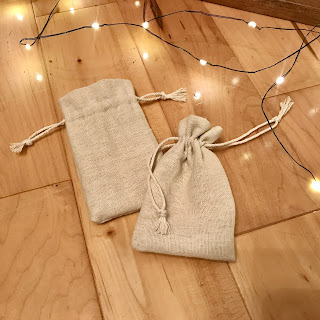When I first shared my Rustic Moose Advent Calendar, I included a quick tutorial on how I sewed my own little treat bags. I'd closed them with a ribbon tie, but ended up finding it a bit too time consuming. This year I decided to revisit that and have come up with a simple drawstring closure that is easy to close and hang up. Lets get started!!
Each bag starts with a 6"x6" square of fabric. I chose a slightly loose woven fabric as I found it easier to thread the drawstring through it, but any light weight fabric could work.
Fold over one edge 1-1/2" and press with an iron.
From the folded edge, stitch two straight lines. I stitched at 5/8" and 1" This will leave a narrow channel for the drawstring to thread through.
Fold the fabric in half and stitch 1/4" from the edge along the open side and bottom. Clip the bottom corners to reduce bulk and turn bag right side out and press with an iron.

I cut two pieces at 10" * each and used a large plastic needle from my knitting supplies to thread it through the channel. I find the plastic needles have a slightly blunt end so don't pierce the fabric as easily when I'm threading it through the channel.
*If you would prefer the addition of a smaller hanging loop, I've added a few extra pics at the bottom of this post on how to achieve that.
Start by pushing the needle through the top layer of fabric only close to the seam. If your fabric weave is too tight for that, you can use scissors to make a very tiny snip being sure to only cut through the outside layer of fabric. Slide the needle through the channel and push it out the opposite side of the bag.
Leaving about 1/4" room, push it back through the fabric and continue through the channel on the other side of the bag exiting close to the seam where you started.
Tie a knot and trim the ends.
Repeat the process starting on the opposite side of the bag using the original holes in the fabric from the first drawstring. You should now have two draw strings in the bag with a knot on each side.
Pull on the knots and the bag closes easily. The finished size of this bag is 2-3/4" x 4-1/4". It's a very simple design and could easily be sized up to any size you need.
At this point you could add numbers with a stamp, decorate the bags to dress them up or leave them as is.
Adding a Small Hanging Loop
I personally love the look of the mini treat bags hanging up closer to the antler. To achieve that, cut your drawstrings at 10" and 13". Thread the 10" drawstring through the channel following my original instructions above. Next, thread the 13" drawstring through but leave the side loop quite loose. Make sure this loop is sitting above the first drawstring.
Tie a small knot leaving a loop large enough to easily slip over a cup hook.
Knot the loose ends and trim to even them up. When the bag is pulled close, the small knot keeps the loop open allowing it to be hung up.
I hope that makes sense and was easy to follow. If you have any questions, definitely let me know.
Happy sewing! :)
Cristina





























































